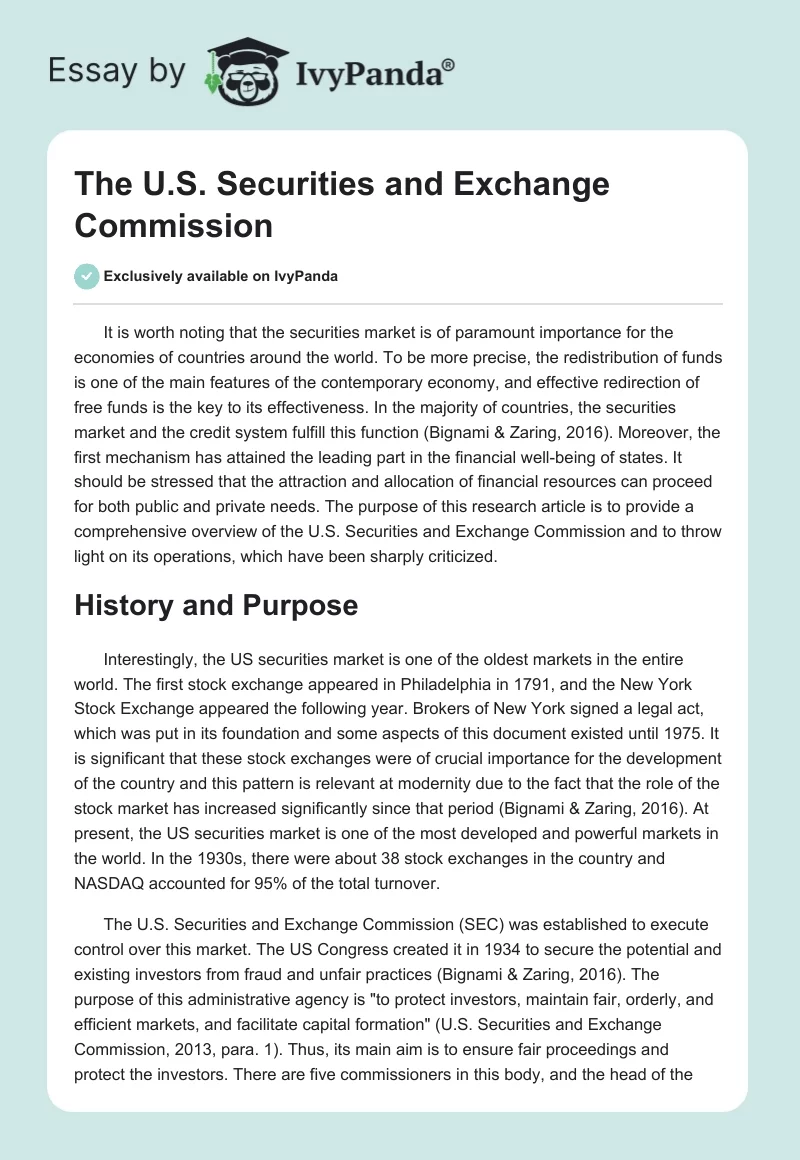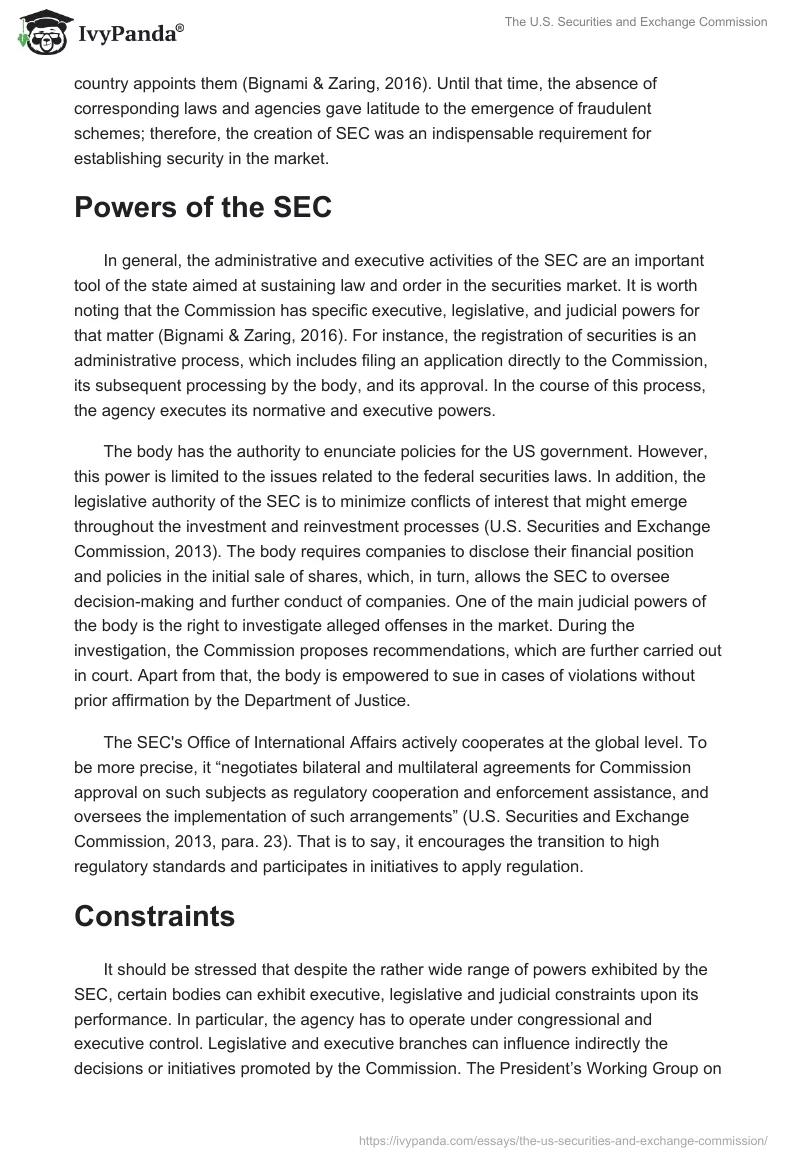It is worth noting that the securities market is of paramount importance for the economies of countries around the world. To be more precise, the redistribution of funds is one of the main features of the contemporary economy, and effective redirection of free funds is the key to its effectiveness. In the majority of countries, the securities market and the credit system fulfill this function (Bignami & Zaring, 2016). Moreover, the first mechanism has attained the leading part in the financial well-being of states. It should be stressed that the attraction and allocation of financial resources can proceed for both public and private needs. The purpose of this research article is to provide a comprehensive overview of the U.S. Securities and Exchange Commission and to throw light on its operations, which have been sharply criticized.
History and Purpose
Interestingly, the US securities market is one of the oldest markets in the entire world. The first stock exchange appeared in Philadelphia in 1791, and the New York Stock Exchange appeared the following year. Brokers of New York signed a legal act, which was put in its foundation and some aspects of this document existed until 1975. It is significant that these stock exchanges were of crucial importance for the development of the country and this pattern is relevant at modernity due to the fact that the role of the stock market has increased significantly since that period (Bignami & Zaring, 2016). At present, the US securities market is one of the most developed and powerful markets in the world. In the 1930s, there were about 38 stock exchanges in the country and NASDAQ accounted for 95% of the total turnover.
The U.S. Securities and Exchange Commission (SEC) was established to execute control over this market. The US Congress created it in 1934 to secure the potential and existing investors from fraud and unfair practices (Bignami & Zaring, 2016). The purpose of this administrative agency is “to protect investors, maintain fair, orderly, and efficient markets, and facilitate capital formation” (U.S. Securities and Exchange Commission, 2013, para. 1). Thus, its main aim is to ensure fair proceedings and protect the investors. There are five commissioners in this body, and the head of the country appoints them (Bignami & Zaring, 2016). Until that time, the absence of corresponding laws and agencies gave latitude to the emergence of fraudulent schemes; therefore, the creation of SEC was an indispensable requirement for establishing security in the market.
Powers of the SEC
In general, the administrative and executive activities of the SEC are an important tool of the state aimed at sustaining law and order in the securities market. It is worth noting that the Commission has specific executive, legislative, and judicial powers for that matter (Bignami & Zaring, 2016). For instance, the registration of securities is an administrative process, which includes filing an application directly to the Commission, its subsequent processing by the body, and its approval. In the course of this process, the agency executes its normative and executive powers.
The body has the authority to enunciate policies for the US government. However, this power is limited to the issues related to the federal securities laws. In addition, the legislative authority of the SEC is to minimize conflicts of interest that might emerge throughout the investment and reinvestment processes (U.S. Securities and Exchange Commission, 2013). The body requires companies to disclose their financial position and policies in the initial sale of shares, which, in turn, allows the SEC to oversee decision-making and further conduct of companies. One of the main judicial powers of the body is the right to investigate alleged offenses in the market. During the investigation, the Commission proposes recommendations, which are further carried out in court. Apart from that, the body is empowered to sue in cases of violations without prior affirmation by the Department of Justice.
The SEC’s Office of International Affairs actively cooperates at the global level. To be more precise, it “negotiates bilateral and multilateral agreements for Commission approval on such subjects as regulatory cooperation and enforcement assistance, and oversees the implementation of such arrangements” (U.S. Securities and Exchange Commission, 2013, para. 23). That is to say, it encourages the transition to high regulatory standards and participates in initiatives to apply regulation.
Constraints
It should be stressed that despite the rather wide range of powers exhibited by the SEC, certain bodies can exhibit executive, legislative and judicial constraints upon its performance. In particular, the agency has to operate under congressional and executive control. Legislative and executive branches can influence indirectly the decisions or initiatives promoted by the Commission. The President’s Working Group on Financial Markets can either sustain or overrule the SEC’s impetus. Apart from that, courts oversee and monitor the agency’s decisions (U.S. Securities and Exchange Commission, 2013). The actions performed by the SEC can be constrained by such initiatives as Administrative Procedure Act. Such laws limit the rulemaking capacities of the agency to a great degree. Moreover, Congress has the potential to control the performance of the Commission. The agency relies directly on the funds authorized by it.
Judicial Review
One the vivid examples when the SEC exercising its powers underwent the judicial review was the case on July 22, 2011. The Court of Appeals for the District of Columbia Circuit revoked the agency’s proxy access rule (Bignami & Zaring, 2016). The legislative body stated that the proposed initiative was arbitrary and the Commission had to reconsider the issue once again. Notably, the agency has provided a 73-page cost-benefit analysis on this rule, but the Court disregarded it. The formation of this rule required 21000 hours of work from the side of the Commission, and its report evidenced the immense expenses allocated to the enforcement of the initiative. One of the factors present in the judicial review was the Constitution. It covered the Commission’s liability towards investors and the population (U.S. Securities and Exchange Commission, 2013). Such aspect as the presence of financial data in terms of registered enterprises also played a major role in the case. Further, the complaints from the side of the general public and the coverage by mass media were the factors to obtain the review.
Apart from the cost-benefit analysis and the immense amount of time spent on the rulemaking, the SEC also experienced significant losses. To be more precise, almost 2.2 million USD were allocated to the formation of the rule. Overall, it should be noted that despite the allocated resources and the efforts made to enact the initiative, the Court overruled it, which was an ineffective practice in its core (Bignami & Zaring, 2016). Apart from the factors mentioned above, the Dodd-Frank financial reform legislation also had the potential to empower the agency in that matter. In addition, the corporate scandals occurring at that time evidenced the right moment for the agency to manifest this rule. Therefore, judicial review was not particularly effective in balancing the SEC’s powers and constraints.
Analysis
It can be argued that the U.S. Securities and Exchange Commission can exhibit certain levels of power within the three branches of authority, which provide it with an opportunity to furnish its duties. Nonetheless, the particular terms and conditions can be applied from the side of the three arms of the government, which can limit the judicial, legislative, and executive/presidential functions of the SEC to the similar extent (Bignami & Zaring, 2016). The Commission has been a subject of criticism from the part of mass media many times. At the time of financial crisis, the media accused the agency of favoritism and securitized credit model mutation. Media stated that some investment banks were given more favored conditions and that certain accounting risks have emerged. Nevertheless, the agency was exercising power within limits granted to it by the Constitution and mandates. Therefore, the judiciary did not allow the SEC to operate within the freedom provided to it and the criticism was unjustified.
Conclusion
Thus, it can be concluded that despite the criticism such agencies as the SEC have been formed to reflect and address the changing human affairs. From that perspective, its main role is to support the existing democratic structure of the government. The agency has assisted in the evolvement of the securities market, and it should be given latitude to continue executing its functions to ensure the well-being of the American economy.
References
Bignami, F., & Zaring, D. (Eds.). (2016). Comparative law and regulation. Northampton, MA: Edward Elgar Publishing.
U.S. Securities and Exchange Commission. (2013). What we do. Web.


